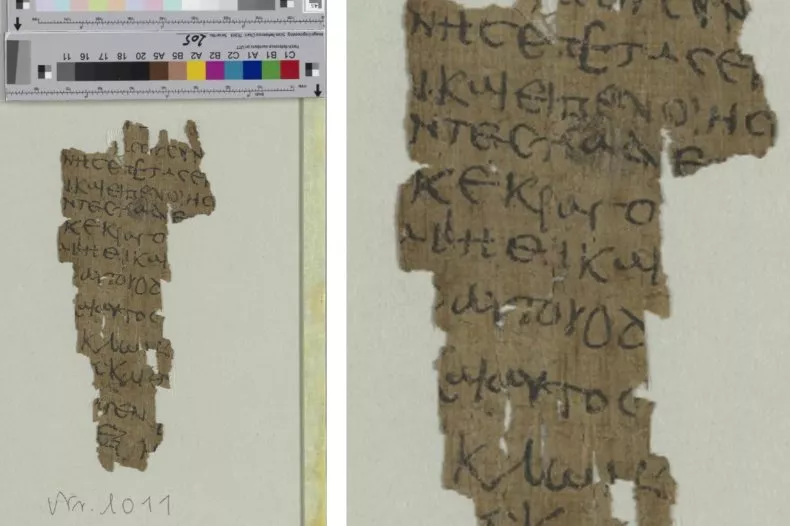In the serene halls of Hamburg, Germany’s Carl von Ossietzky State and University Library, a fragment of papyrus lay unnoticed for decades. This seemingly insignificant piece of ancient Greek text has now been identified as the oldest known version of the Infancy Gospel of Thomas (IGT).
The Discovery of the Manuscript
The journey of this ancient manuscript began in the quiet corners of the Carl von Ossietzky State and University Library. For years, it was overlooked, mistaken for an everyday document due to its clumsy handwriting. However, a pair of researchers, driven by curiosity and scholarly dedication, embarked on a mission to uncover its true nature. Their efforts led to the revelation that this fragment was, in fact, a copy of the Infancy Gospel of Thomas, dating back to the 2nd century A.D.
What is The Infancy Gospel of Thomas?
The Infancy Gospel of Thomas is one of the apocryphal infancy gospels, a collection of early Christian writings that are not part of the canonical Bible. These texts provide a unique glimpse into the childhood of Jesus, offering stories and teachings that are absent from the New Testament.
The IGT, in particular, focuses on the miraculous and sometimes mischievous deeds of young Jesus, painting a vivid picture of his early years.
The Significance of the Discovery
The discovery of the oldest known version of the IGT is a monumental achievement in the field of biblical studies. It not only provides a more accurate understanding of early Christian literature but also sheds light on the historical and cultural context in which these texts were written. This manuscript serves as a valuable resource for scholars seeking to unravel the complexities of early Christian theology and its development over time.
Deciphering the Manuscript
Deciphering an ancient manuscript is no small feat. The researchers faced numerous challenges, from the fragment’s deteriorated condition to the clumsy handwriting that initially led to its misidentification. However, their perseverance and expertise in ancient Greek texts enabled them to piece together the fragmented lines and uncover the hidden narrative within.
Modern technology played a crucial role in the deciphering process. By comparing the fragment with digitized versions of other known manuscripts, the researchers were able to identify key words and phrases, ultimately confirming its identity as the IGT. This technological assistance not only expedited the process but also ensured a higher degree of accuracy in the transcription.
The moment of revelation came when the researchers identified the word “Jesus” within the text. This discovery set off a chain of comparisons with other manuscripts, leading to the conclusion that this fragment was indeed the earliest known version of the IGT. The significance of this finding cannot be overstated, as it provides a direct link to the early Christian communities that produced and circulated these texts.
Historical Context of the Infancy Gospel of Thomas
The Infancy Gospel of Thomas is believed to have been written in the 2nd century A.D., a period marked by the proliferation of Christian texts and teachings. This era saw the emergence of numerous apocryphal gospels, each offering different perspectives on the life and teachings of Jesus. The IGT, with its focus on Jesus’ childhood, stands out as a unique contribution to this body of literature.
The apocryphal gospels, including the IGT, were often excluded from the canonical Bible due to their divergent narratives and theological implications. However, these texts provide valuable insights into the diversity of early Christian thought and the ways in which different communities understood and interpreted the life of Jesus. The IGT, in particular, offers a glimpse into the childhood of Jesus, a period largely absent from the canonical gospels.
The 2nd century A.D. was a time of significant cultural and religious transformation. The early Christian communities were navigating a complex landscape of competing beliefs and practices, and the production of texts like the IGT reflects their efforts to articulate and preserve their unique theological perspectives. Understanding the historical context of the IGT is essential for appreciating its significance and the role it played in shaping early Christian thought.
Theological Implications of the IGT
The IGT presents a unique portrayal of Jesus’ childhood, characterized by miraculous events and divine interventions. These stories, while not part of the canonical gospels, offer a different perspective on Jesus’ early years and his development as a spiritual leader. The portrayal of young Jesus in the IGT is both fascinating and complex, revealing a side of his character that is often overlooked in traditional narratives.
One of the most striking aspects of the IGT is its depiction of Jesus’ miraculous deeds as a child. From healing the sick to bringing clay birds to life, these stories highlight the divine nature of Jesus and his extraordinary abilities. These miracles serve as a testament to his unique identity and foreshadow the miraculous events of his later life.
The IGT has been the subject of various theological interpretations, with scholars debating its significance and implications for understanding the life of Jesus. Some view it as a valuable addition to the body of early Christian literature, while others see it as a reflection of the diverse and sometimes conflicting beliefs within the early Christian communities. Regardless of one’s perspective, the IGT offers a rich and nuanced portrayal of Jesus’ childhood that invites further exploration and reflection.
The Manuscript’s Journey to Modern Times
The journey of the IGT manuscript from its creation in the 2nd century A.D. to its rediscovery in the modern era is a testament to the enduring legacy of early Christian texts. The fragment’s preservation and eventual identification highlight the importance of libraries and archives in safeguarding our cultural and religious heritage.
The Role of Scholars
The rediscovery of the IGT manuscript would not have been possible without the dedication and expertise of scholars in the field of biblical studies. Their meticulous research and commitment to uncovering the truth have brought this ancient text to light, allowing us to gain a deeper understanding of early Christian literature and its significance.
The Impact on Biblical Studies
The identification of the oldest known version of the IGT has significant implications for the field of biblical studies. It provides a valuable resource for scholars seeking to understand the development of early Christian thought and the ways in which different communities interpreted the life of Jesus. This discovery also underscores the importance of continued research and exploration in uncovering the hidden treasures of our religious heritage.
Discover more from Jesus Quest
Subscribe to get the latest posts sent to your email.



